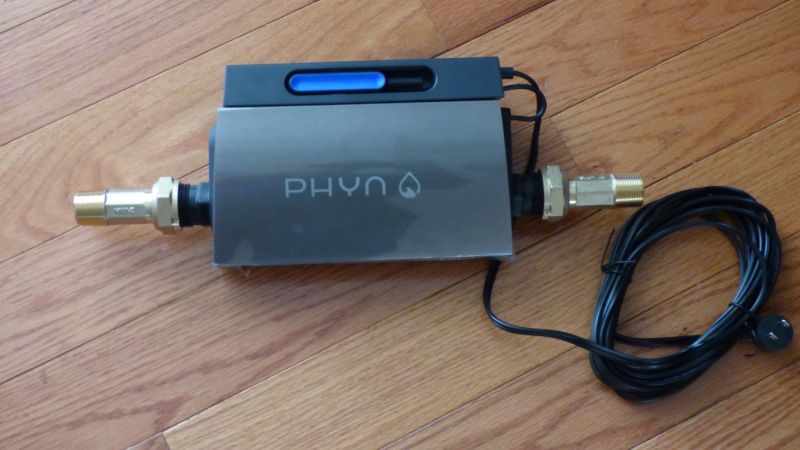
REVIEW – A few months ago, my neighbor had a burst washing machine water line, resulting in substantial damage, a huge mess, large expense, and a lot of frustration. It got me thinking that there should be a better way to prevent this from happening. I’m thrilled that the Phyn Plus Smart Assist shutoff should be able to alleviate situations like this.
What is it?
The Phyn Plus is an electrically controlled valve assembly that monitors water use, detects leaks, and can turn on or off the water in a home automatically or through a smartphone app.
Hardware Specs
- 8.43 x 5.6 x 2.97 inches
- Weighs 2.2 pounds
- 120/220VAC, 19 Watts power consumption (GFI recommended)
- 15-foot cable
- Horizontal or Vertical mounting
- Indoor/Outdoor rated
- Male pipe threads integrated into the device for easy connection
- Full-bore construction
- Single-device home protection
- Plumbing “health checks”
- Free Phyn App (iOS 9 or later, Android 4.1 or later supported)
- Leak alert notifications
- Manual shutoff tool included
- Dual internal antennas, External antenna port (external antenna is optional)
- Wi-Fi required, 802.11 b/g/n 2.4GHz
- RGB LED display
- Ultrasonic water flow detection
- High definition pressure sensor accurate to +/- 1%
- Temperature sensor +/-.05
- Potable water safe
- UL, FCC, and NSF certified
- 2-year limited warranty
What’s in the Box?
- Phyn Plus
- Manual shutoff tool
- Installation instructions
- User manual
- Installer toolkit containing screws. Wall-mount anchors and cable ties
- Referral postcards
- 3/4 –inch adapter fittings and gaskets
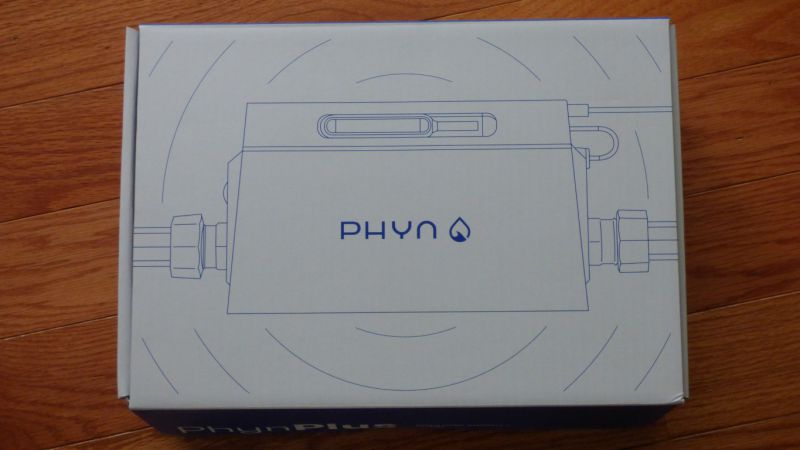
Design and Features
The Phyn Plus arrived in a snazzy, sturdy box, nested in another box in cardboard comfort.
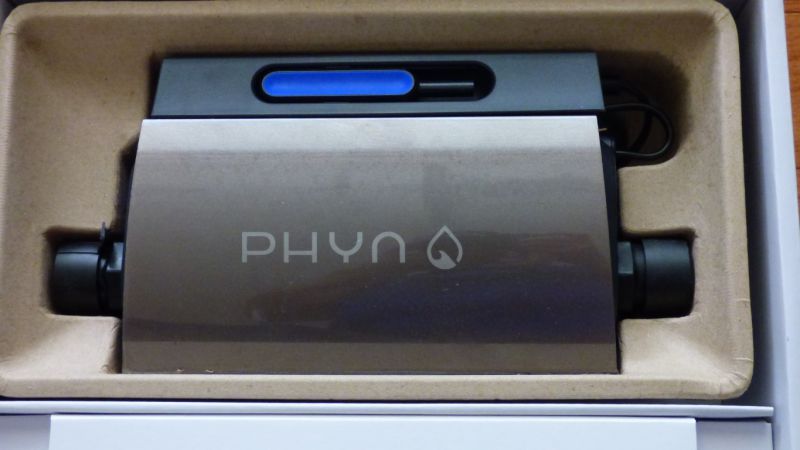
The included fittings are threaded. The installation will require adapters and piping to connect to your existing water system. Be aware, with the fitting adapters in place the entire assembly is almost 17-inches long. Make sure you have enough space. Professional installation is recommended, but if you are handy around the house, you can install it yourself, although, in tight spaces like mine, you might need to make some Dr. Seuss pipe bends.
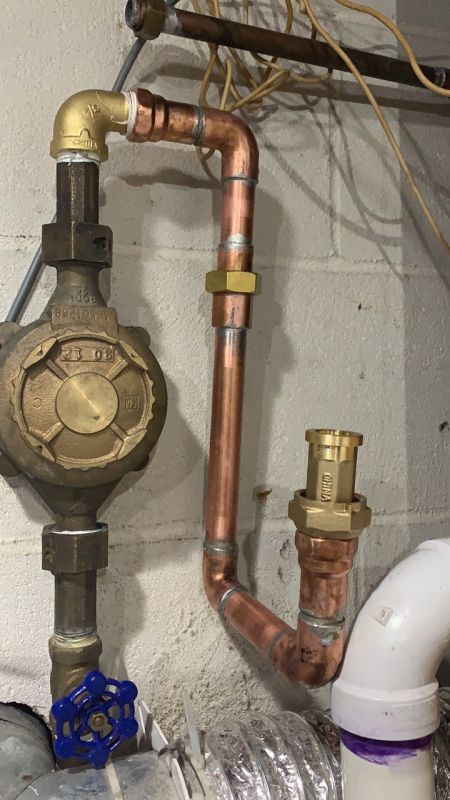
Installation took me an afternoon and it’s necessary to turn the water off completely, drain and cut the pipes, and fit the Phyn Plus in place.
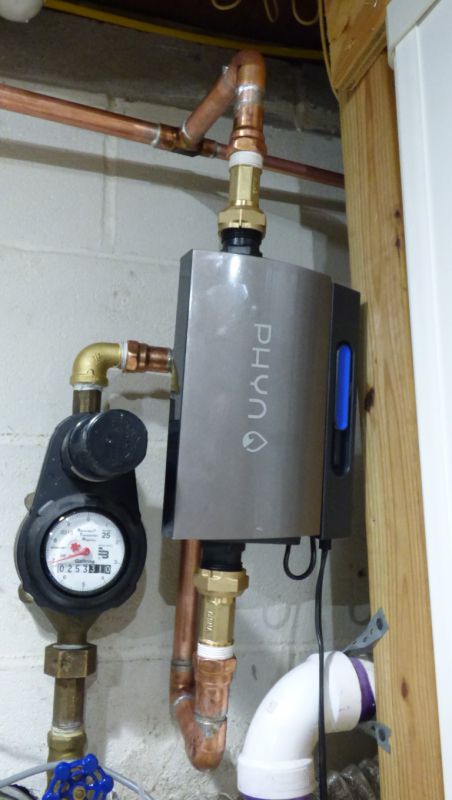
After completion, powering up for the first time is quite a light show. Mesmerizing blue and white lights adorn the side of the valve. Should the manual pushbutton be used to close the valve, a red line and blocked water is indicated on the display. Pretty slick.

Interestingly, most of the time the display is blank, even with water flowing or during valve operation. I would like to see the option to turn the display on to show when water is flowing if there are leaks, or other system status indications.
At one point I experienced an issue with the valve not fully opening, but a quick email to Phyn had the issue rectified in a jiffy. Customer service was courteous and responsive.
Over the course of the next week, I ran the valve through many close/open cycles which take about eight seconds, as well as “plumbing checks” which take about four minutes. I was very impressed with the accuracy of the readings and the system’s responsiveness.
Moving on to water usage, the system “listens” and learns the signatures of plumbing fixtures and gives a reading of how your home uses water. It’s interesting and valuable data. You can help the system learning process along by identifying fixtures as water is used.
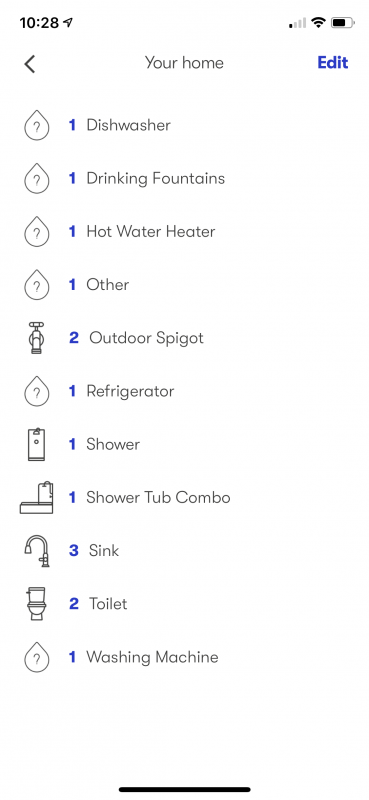
The Phyn Plus system takes about 1000 “events” (defined as operations of water sources in the home) to learn enough usage to automatically turn the water off due to a leak or burst water line. It’s possible to manually turn this feature on, but it might not function as intended and turn off the water if someone takes a particularly long shower. For me, it took about a month to learn my water usage habits. This review was particularly challenging due to the time required for learning and testing, but it was time well spent.
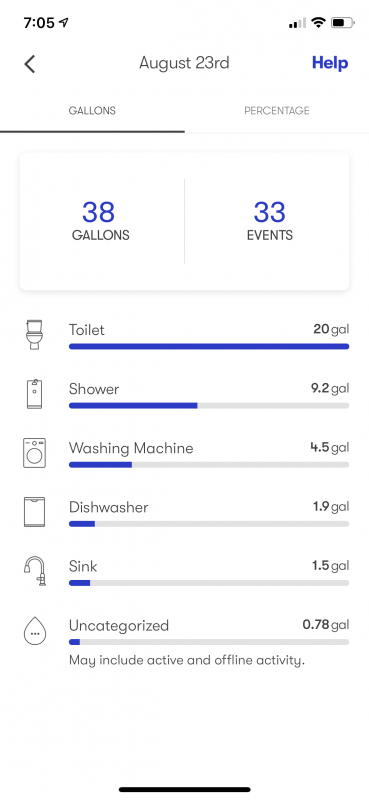
If your plumbing system should develop a small leak (an under-tightened faucet for example) with a flow of less than 0.1 gallons-per-minute, a daily pluming check sends a message indicating a pressure drop, prompting to give fixtures a look. This worked flawlessly over several weeks of testing.
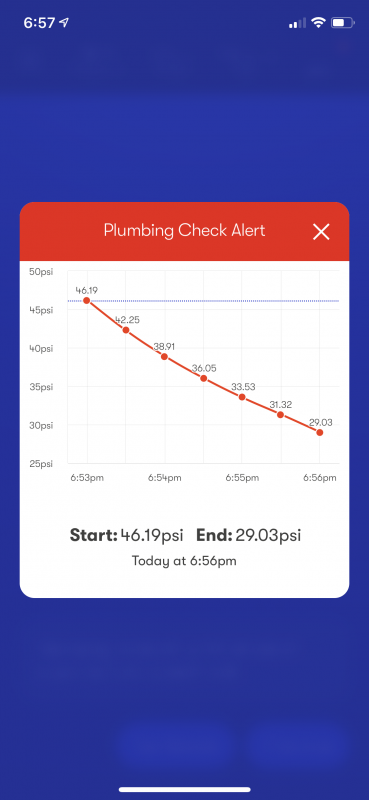
For small leaks, a daily automatic pressure test informed me that there was a loss in my home’s water system pressure – the larger the leak, the greater the drop. This could translate to an under-tightened faucet handle (be prepared to scold your kids : -) ) to a pinhole pipe leak. As soon as I had the valve installed, it detected a small leak in my system. Since the Phyn Plus is mounted over my sump-pump crock, drips would have mixed with ground water and I likely would have been overlooked for months or even years, costing me a small fortune in slowly wasted water. Bravo Phyn!
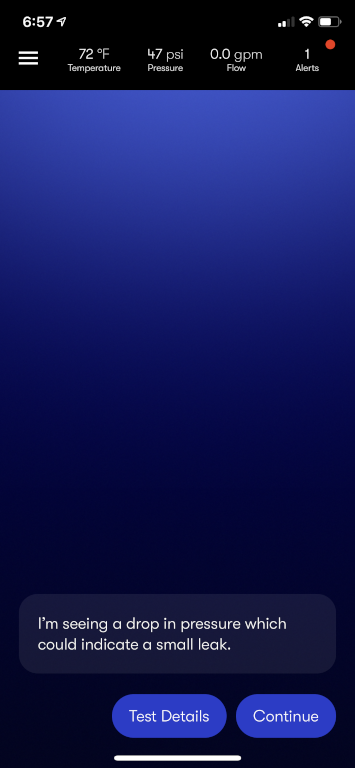
Phyn’s app makes suggestions for resolution.
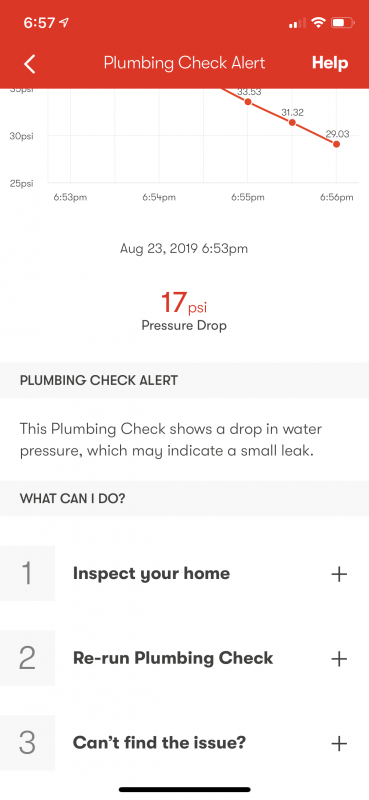
Phyn can also send text messages when something is amiss.
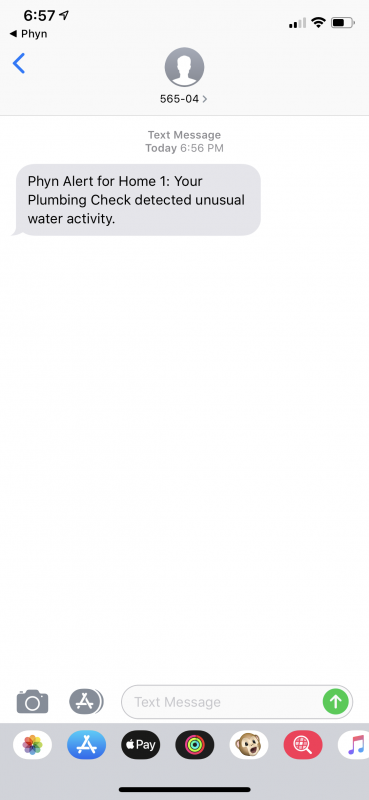
A few twists of the wrench and my system was water-tight again.
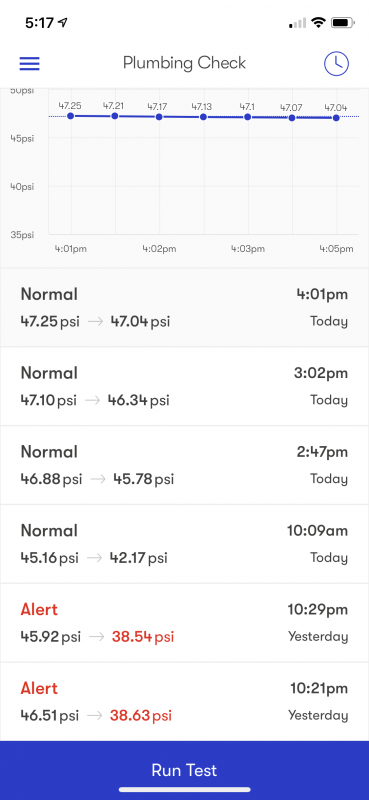
For a leak of larger than 0.1 gallons-per-minute, I received an alert that there was an issue. From the start of the “leak” to the automatic shutoff, only 30 minutes had elapsed. This translates from a small leak of 0.1 GPM producing about 3 gallons, about ½ a sink’s depth of water.
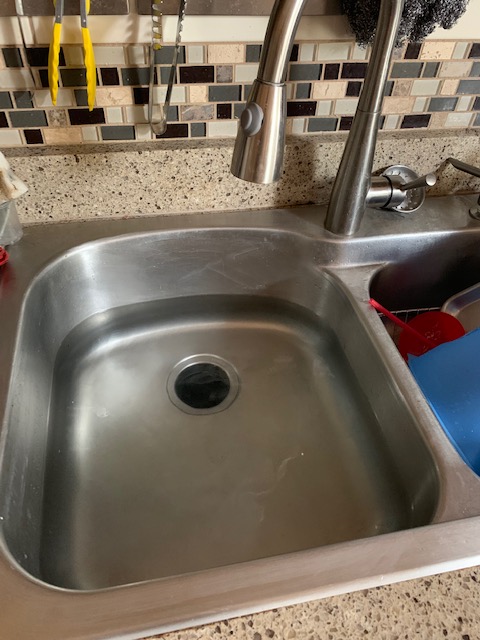
Alternatively, I could have manually turned the water off remotely at the first sign of trouble when the Phyn Plus sent the first messages, 15 minutes after water first started to flow.
Should the horrible occur akin to my neighbor’s ruptured washer line, automatic shutoff would occur after 30 minutes of water flowing (in my case) at 4.5 GPM, resulting in 135 spilled gallons. This might sound like a lot, but without the Phyn Plus, 8 hours of water would be 2160 gallons on my floor just for a workday. If I were on vacation, 7 days of water flowing in my basement would amount to a colossal 45,360 gallons! Of course, if your water pressure is higher than mine, considerably more water would have been lost. To add insult to injury, my water bill would have increased by $252.
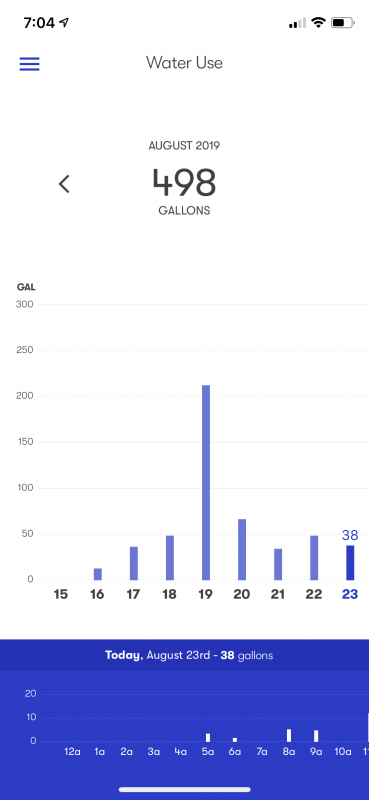
Hmmm, let’s see… over a week, 135 gallons of lost water versus 45,360 gallons… It’s the difference between damp carpets I can clean up myself with a fan and wet-vacuum or replacing everything in a furnished basement. The Phyn Plus wound have saved a furnace, AC, beds, sofas, washer, dryer, carpet, home theater, drywall, and electrical wiring to name a few. In my home’s case, my sump pump would have been able to drain off some of the spilled basement water, but if the rupture had been on the first floor of my home, I certainly would have kissed my hardwood floors goodbye
Clearly, Phyn Plus is a hero!
What I like
- Automatic shut off
- Remote operation
- Lots of useful water usage data
- Great customer service
- Capable app with ample alerts
- Self-learning of my water usage habits
What I would change
- More use of the LED display would be welcomed.
Final thoughts
The Phyn Plus is one of those gadgets that could mean the difference between a minor inconvenient water spill and full-blown home devastation. It’s pricy, but one event might save far more than the cost to purchase and install.
Price: $699.00
Where to buy: Phyn Plus
Source: The sample for this review was provided by Phyn LLC.



Gadgeteer Comment Policy - Please read before commenting
Nice review, I’d love one but that’s a pricey product!
After a month of use, how does Phyn’s “gallons used” measurement compare to the city water meter usage?
Also, does it still have full functionality without an internet connection or does it need cloud services to work?
Aaron, Cloud services are needed for fun functionality.
After several months of use, The Phyn’s water use is virtually identical to my residential water meter.
You are correct, it’s pricey, but considerably less so than a water clean-up and far less stressful, been there, done that.
I’d also like to know what happens when the power goes out – both in regular mode and if it’s closed itself off to prevent a leak.
The unit retains its last state during a power loss. Phyn provides a small took that can be used to open or close the valve should this occur.
Is it also suitable for the rest of the world, as only America is stuck in the dark ages still using imperial measuring. ? Can this thing measure in liters ?
Yes, user settings can configure the Phyn for Imperial or metric units.
XFINITY USERS BEWARE!
The Phyn Plus I’ve had for 36 days has had numerous connectivity issues with my Xfinity Wi-Fi. I’ve spent hours and hours with the Phyn Support team who has refused to engage in troubleshooting with my Xfinity Tier-3 representative. I have numerous home devices that are connected to my Xfinity Wi-Fi just fine. Instead of the Phyn software development team working with one of the largest national cable Internet companies, Phyn Support blames Xfinity, and Xfinity blames Phyn. My request for a refund has been denied, having the unit for slightly over the 30-day refund period… REASON = XFINITY ISSUE.
I now have a useless, expensive $800+ manual and difficult shutoff valve!
I’ll also intend to file a complaint with Better Business Bureau.
If you are an XFINITY Wi-Fi user, run from this product… Buyer Beware!!
I’m sorry to hear that you seem to be facing similar issues to myself. I received had Phyn Plus installed in November 2019 and had WiFi connectivity issues from the start. In endless discussions with phyn support, they steadfastly refused to acknowledge that the connectivity problems are due to the phyn radio (despite evidence to the contrary).
But then I noticed that the device had failed to do any plumbing check for almost two months due to a problem with the valve. According to support, this also meant that I was not protected against leakage or broken pipes under that period because the deceive would have failed to close the valve. According to support, the software knew about the problem (which is why it stopped doing the nightly checks, which include closing the valve for a few minutes) so surely I would be notified about the valve not being operable? Nope. Was that by design or was it a bug? Support can’t say. But at least they concluded in May or June 2020 that the unit needs to be swapped for a new one. And you know what, it took them less than two months to do that.
And guess what: The connectivity issues disappeared as soon as the new unit was installed.
However, my data from nov 2019 till July 2020 was not transferred (yes, it’s stored in the cloud, but it’s connected to the old device and apparently they cannot switch it over to the new one. And they refuse to give me my data in a machine readable format. So I had to start from scratch training the device’s AI to recognize the different water events. After over a year of correcting repeated miscategorizations of “water events”, I have given up and have to conclude that it simply doesn’t work. The data is unusable for anything but an estimate of the total consumption (I haven’t dared to check how accurate the actual measurement is, so I just naively assuming that it is somewhat accurate.)
So I completely agree with you (Lou): stay far away from Phyn. They are not taking this product seriously and promise way more than it can deliver.
Thanks a lot for the detailed review. I’m wondering: is there really no way to configure the waiting time before water is turned off when a leak or “abnormal usage” is detected? 15 minutes seems a goid default, but I’d like to be able to set that to a shorter period.
And another thing that bugs me with the device is: how dependent is it on Phyn the company and more specifically its servers? This seems relevant for three reasons: if the internet connection breaks down (e.g. during vacation), will Phyn let a burst pipe flood my home? (My hope is that it will shut the water off after those 15 minutes have passed). Second, since a lot of the analysis seems to be done in the cloud, will my device be able to detect anything at all without Internet connection? And will it still log water usage without access to the phyn servers? Last, but not least, this is quite an investment, not something to change or replace any time soon. But companies come and go, get bought by others who then shut down products, modify them or start charging for previously free services. When I read the Phyn Terms and Conditions, I find absolutely nothing that reassures me that I will be able to use the device if, say, the company ceases to exist or shuts down its servers. Do you have any insights regarding this?
The shutoff feature is not adjustable, but could always be updated into the software should Phyn’s R&D folks deem it necessary.
I don’t have any insights into longevity should there be an interruption in services from Phyn. I’m also not privy to the amount of data the device shares with servers beyond what’s available in the app.
I worry a-lot about cloud dependent Smarthome devices. I tend to try and keep everything I use homeseer compatible. This way “I am my own cloud”. I do want to get a monitor for water, just because it’s cool. Currently I’m on a well, so simply killing power to my well is my “shutoff” but this looks very interesting.
I am on a well system with a pressure tank. My irrigation system comes before my home shutoff valve. My concern is being gone and my garden irrigation systems break. As I read the product info, the Phyn-plus system would close a valve and protect everything downstream from the valve. Have you considered a system where it could simply kill power to the well circuit? Such an upgrade would benefit us with rural systems.